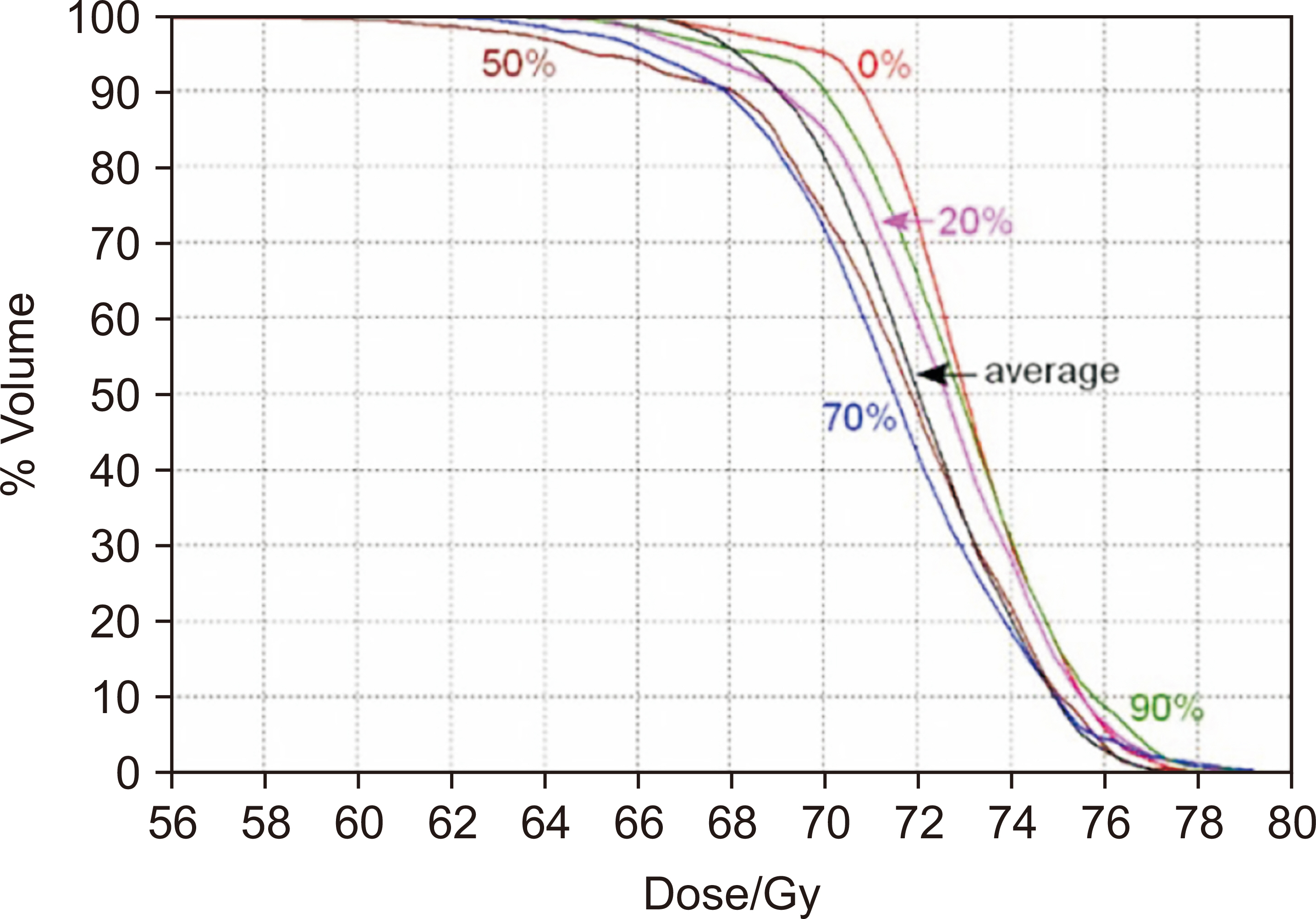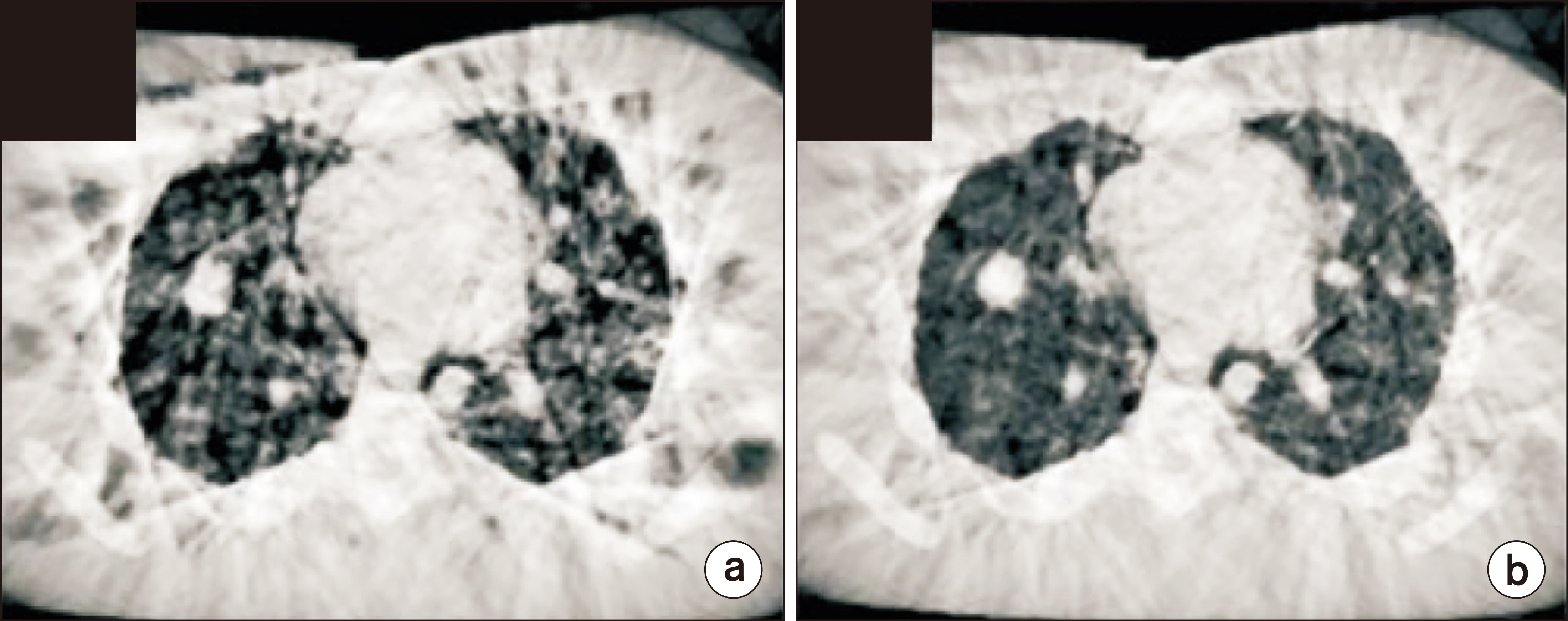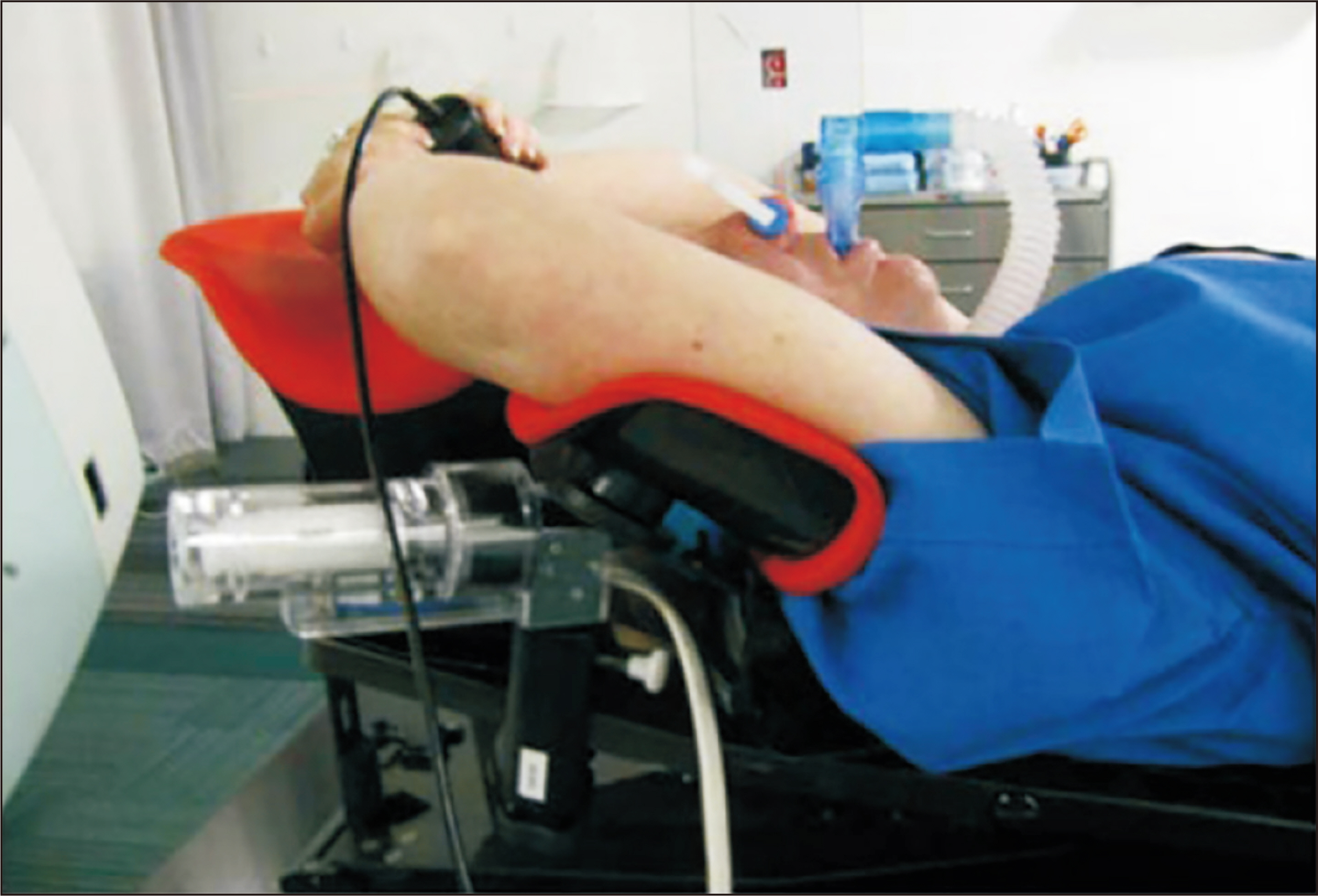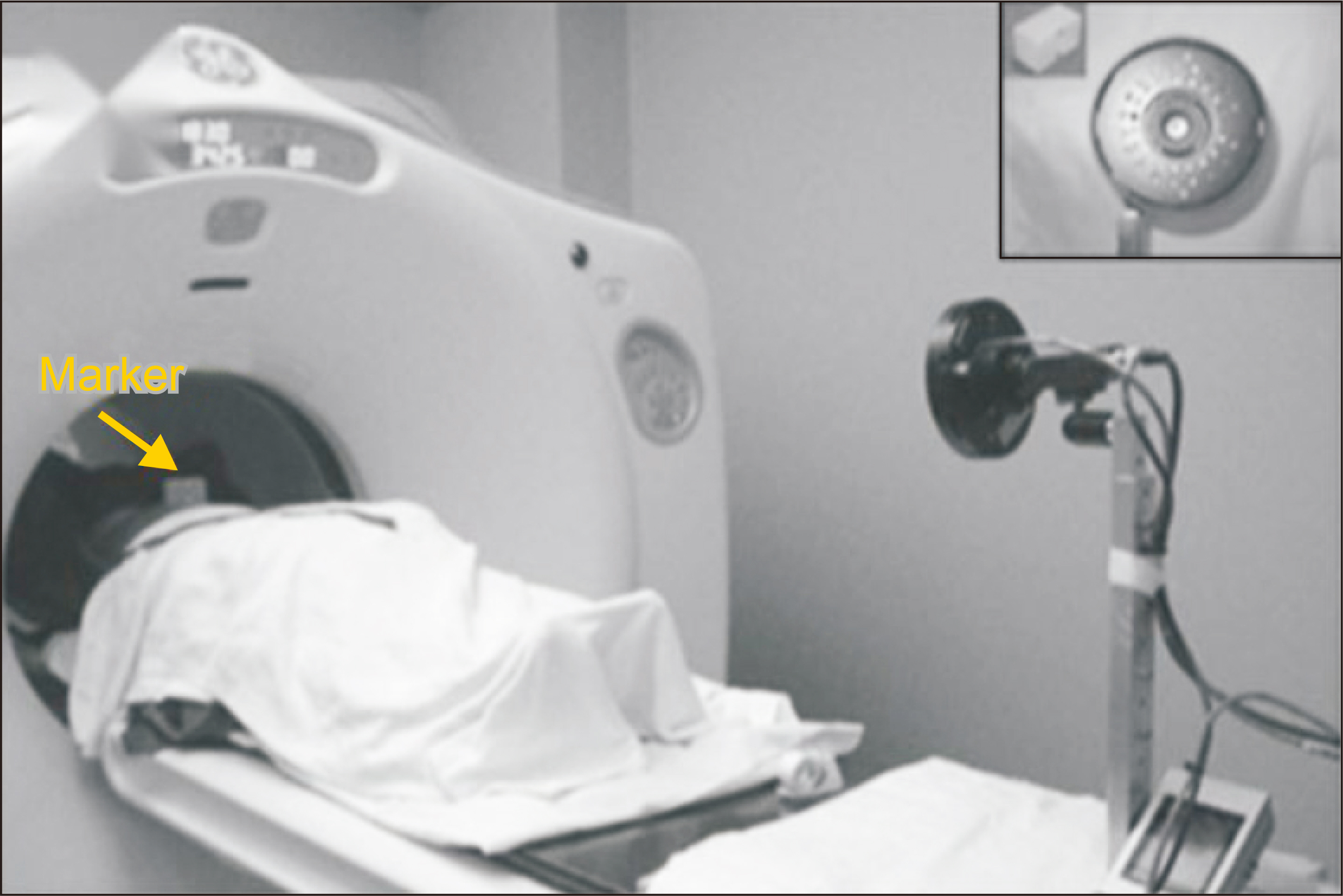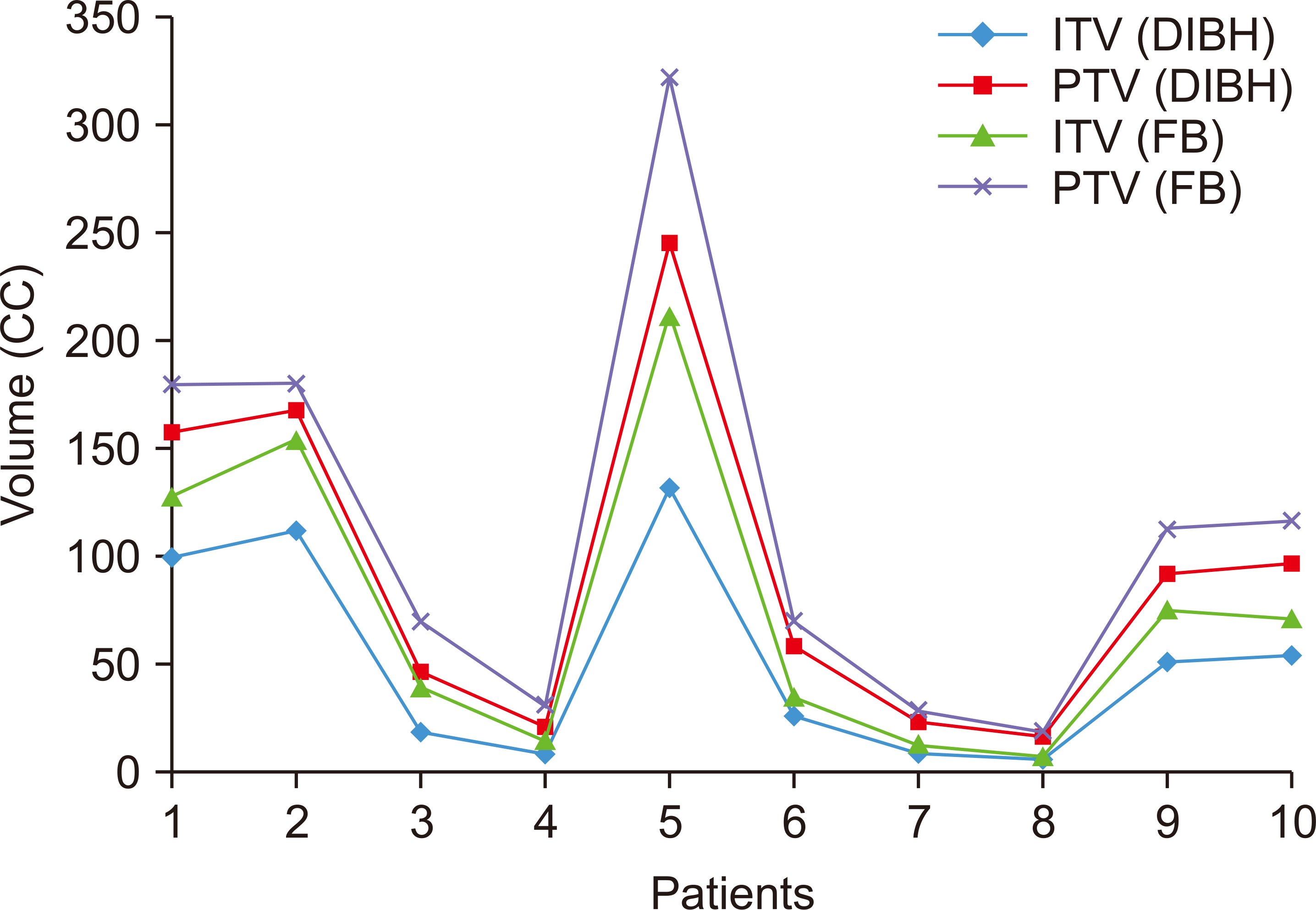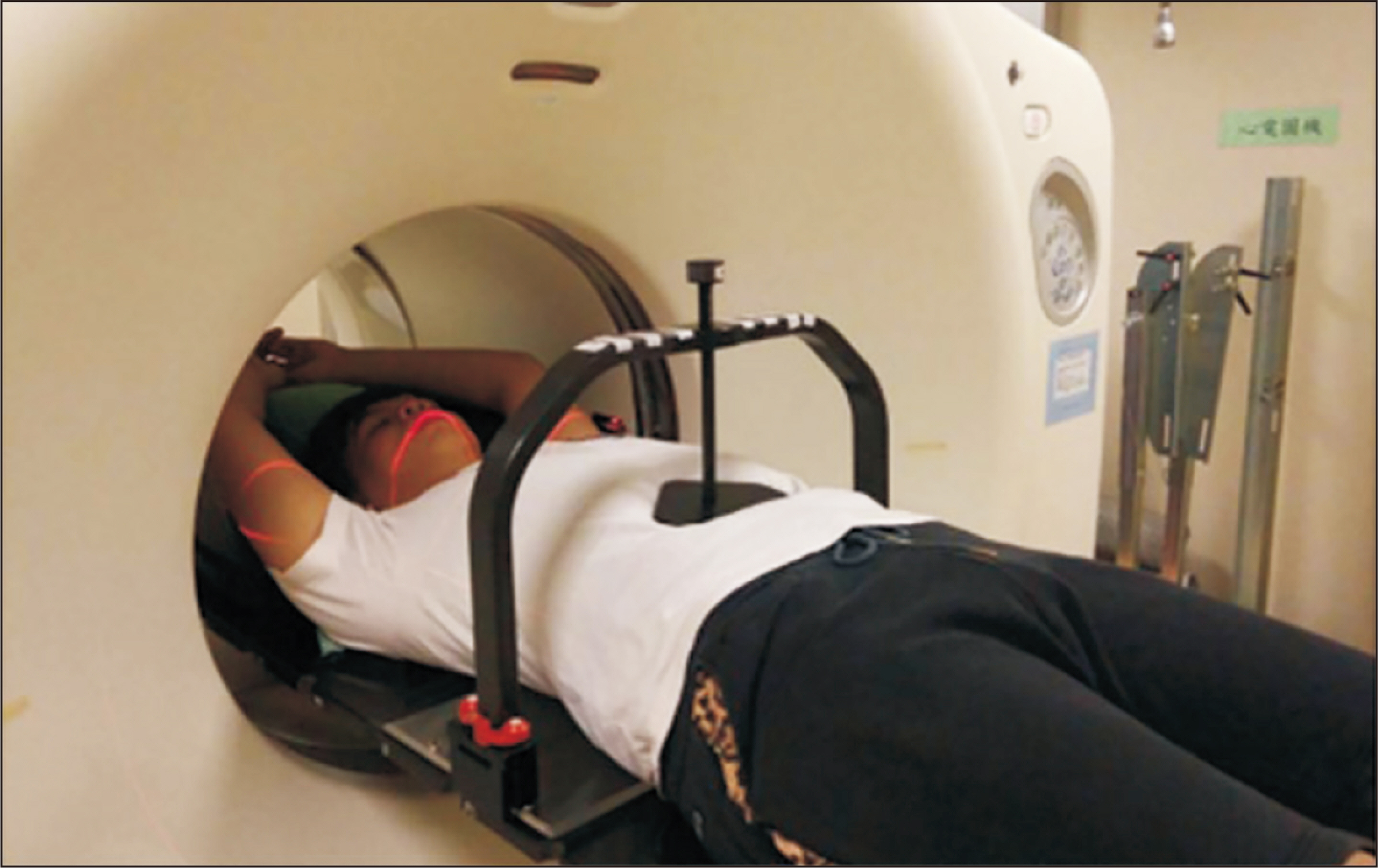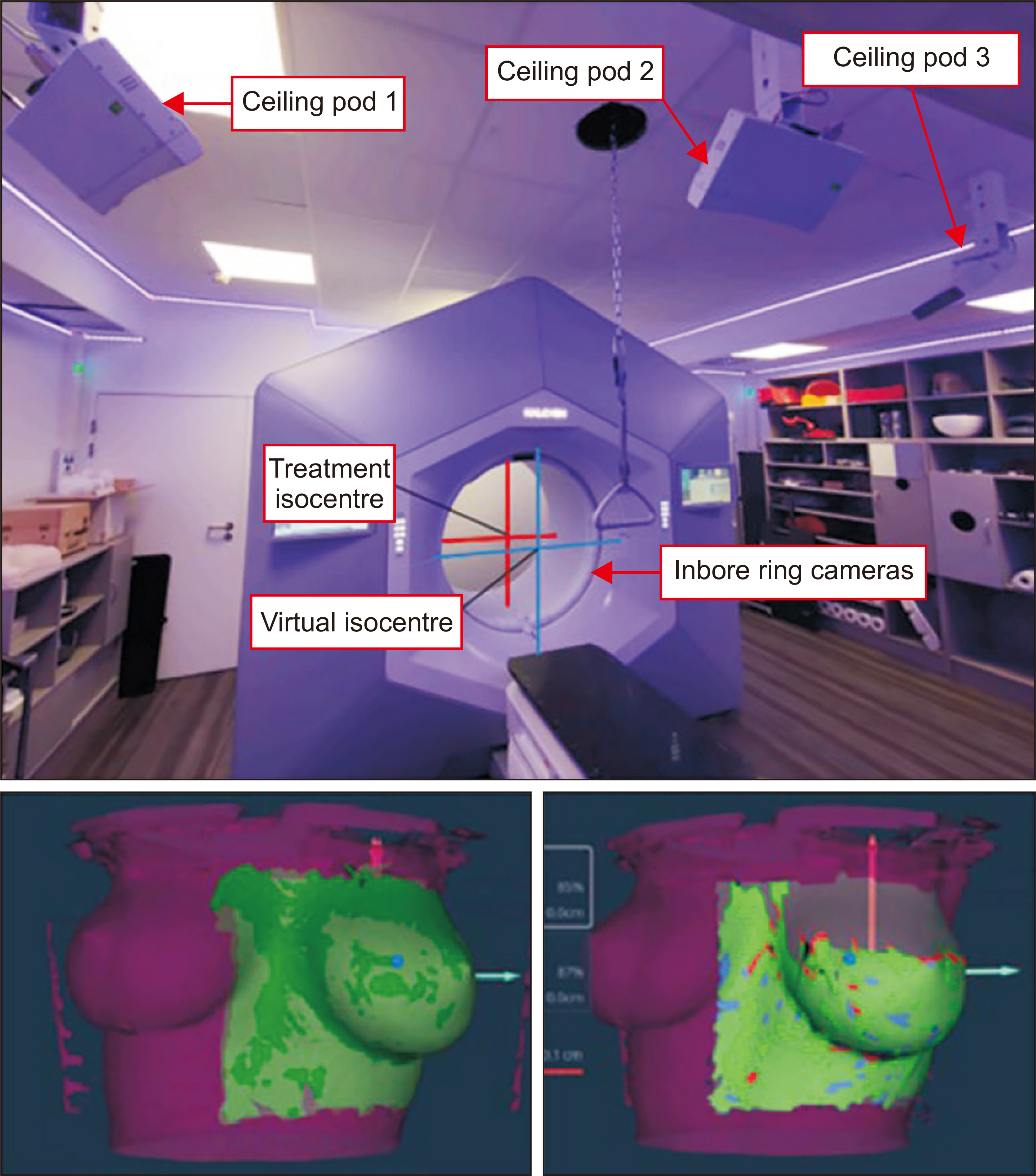Prog Med Phys.
2024 Jun;35(2):21-35. 10.14316/pmp.2024.35.2.21.
Motion Management and Image-Guided Technique in Photon Radiation Therapy: A Review of an Advanced Technology
- Affiliations
-
- 1Department of Radiation Oncology, Seoul National University Hospital, Seoul, Korea
- 2Institute of Radiation Medicine, Seoul National University Medical Research Center, Seoul, Korea
- 3Biomedical Research Institute, Seoul National University Hospital, Seoul, Korea
- 4Department of Radiation Oncology, Seoul National University College of Medicine, Seoul, Korea
- KMID: 2557156
- DOI: http://doi.org/10.14316/pmp.2024.35.2.21
Abstract
- Herein, we provide a concise review of the critical role of motion management in radiation therapy, with a focus on photon radiation therapy, real-time control of respiratory motion, and image-guided radiation therapy (IGRT) in lung stereotactic body radiation therapy (SBRT). The dynamic nature of human anatomy, particularly in regions prone to movement such as the thoracic and abdominal areas, poses significant challenges in accurately targeting tumors during radiation therapy. This review explores the implications of organ and tumor motion, emphasizing the necessity for precise treatment delivery. We assess the advancements in four-dimensional (4D) imaging techniques such as 4D computed tomography, which provide time-resolved images for enhanced treatment planning. The review highlights various motion management strategies, including motionencompassing methods, respiratory-gating, breath-hold techniques, and real-time tumor tracking, discussing their implementation and impact on treatment efficacy. The role of IGRT in lung SBRT is particularly emphasized, showcasing how real-time imaging and advanced targeting techniques enhance the precision of high-dose radiation delivery while minimizing exposure to surrounding healthy tissues. This comprehensive review aims to underscore the significance of integrating motion management in radiation therapy, highlighting its pivotal role in improving treatment accuracy, reducing toxicity, and ultimately enhancing patient outcomes in cancer care.
Keyword
Figure
Reference
-
References
1. Wang JZ, Li JB, Wang W, Qi HP, Ma ZF, Zhang YJ, et al. 2015; Changes in tumour volume and motion during radiotherapy for thoracic oesophageal cancer. Radiother Oncol. 114:201–205. DOI: 10.1016/j.radonc.2014.12.010. PMID: 25595652.
Article2. Botticella A, Levy A, Auzac G, Chabert I, Berthold C, Le Pechoux C. 2021; Tumour motion management in lung cancer: a narrative review. Transl Lung Cancer Res. 10:2011–2017. DOI: 10.21037/tlcr-20-856. PMID: 34012810. PMCID: PMC8107759.
Article3. Eminowicz G, Motlib J, Khan S, Perna C, McCormack M. 2016; Pelvic organ motion during radiotherapy for cervical cancer: understanding patterns and recommended patient preparation. Clin Oncol (R Coll Radiol). 28:e85–e91. DOI: 10.1016/j.clon.2016.04.044. PMID: 27178706.
Article4. Langen KM, Jones DT. 2001; Organ motion and its management. Int J Radiat Oncol Biol Phys. 50:265–278. DOI: 10.1016/S0360-3016(01)01453-5. PMID: 11316572.
Article5. Keall P. 2004; 4-dimensional computed tomography imaging and treatment planning. Semin Radiat Oncol. 14:81–90. DOI: 10.1053/j.semradonc.2003.10.006. PMID: 14752736.
Article6. Keall PJ, Joshi S, Vedam SS, Siebers JV, Kini VR, Mohan R. 2005; Four-dimensional radiotherapy planning for DMLC-based respiratory motion tracking. Med Phys. 32:942–951. DOI: 10.1118/1.1879152. PMID: 15895577.
Article7. Cho B, Poulsen PR, Keall PJ. 2010; Real-time tumor tracking using sequential kV imaging combined with respiratory monitoring: a general framework applicable to commonly used IGRT systems. Phys Med Biol. 55:3299–3316. DOI: 10.1088/0031-9155/55/12/003. PMID: 20484777. PMCID: PMC2974817.
Article8. Bertholet J, Knopf A, Eiben B, McClelland J, Grimwood A, Harris E, et al. 2019; Real-time intrafraction motion monitoring in external beam radiotherapy. Phys Med Biol. 64:15TR01. DOI: 10.1088/1361-6560/ab2ba8. PMID: 31226704. PMCID: PMC7655120.
Article9. Kang SH, Kim S, Kim DS, Kim TH, Park SH, Shin DS, et al. 2017; A method of respiratory phase optimization for better dose sparing of organs at risks: a validation study in patients with lung cancer. Oncotarget. 9:205–216. DOI: 10.18632/oncotarget.23353. PMID: 29416607. PMCID: PMC5787457.
Article10. Jadon R, Pembroke CA, Hanna CL, Palaniappan N, Evans M, Cleves AE, et al. 2014; A systematic review of organ motion and image-guided strategies in external beam radiotherapy for cervical cancer. Clin Oncol (R Coll Radiol). 26:185–196. DOI: 10.1016/j.clon.2013.11.031. PMID: 24566332.
Article11. Chan P, Dinniwell R, Haider MA, Cho YB, Jaffray D, Lockwood G, et al. 2008; Inter- and intrafractional tumor and organ movement in patients with cervical cancer undergoing radiotherapy: a cinematic-MRI point-of-interest study. Int J Radiat Oncol Biol Phys. 70:1507–1515. DOI: 10.1016/j.ijrobp.2007.08.055. PMID: 18164850.
Article12. Balter JM, Lam KL, Sandler HM, Littles JF, Bree RL, Ten Haken RK. 1995; Automated localization of the prostate at the time of treatment using implanted radiopaque markers: technical feasibility. Int J Radiat Oncol Biol Phys. 33:1281–1286. DOI: 10.1016/0360-3016(95)02083-7. PMID: 7493853.
Article13. Nederveen A, Lagendijk J, Hofman P. 2000; Detection of fiducial gold markers for automatic on-line megavoltage position verification using a marker extraction kernel (MEK). Int J Radiat Oncol Biol Phys. 47:1435–1442. DOI: 10.1016/S0360-3016(00)00523-X. PMID: 10889399.
Article14. Roach M 3rd, Pickett B, Rosenthal SA, Verhey L, Phillips TL. 1994; Defining treatment margins for six field conformal irradiation of localized prostate cancer. Int J Radiat Oncol Biol Phys. 28:267–275. DOI: 10.1016/0360-3016(94)90167-8. PMID: 8270451.
Article15. Yan D, Lockman D, Brabbins D, Tyburski L, Martinez A. 2000; An off-line strategy for constructing a patient-specific planning target volume in adaptive treatment process for prostate cancer. Int J Radiat Oncol Biol Phys. 48:289–302. DOI: 10.1016/S0360-3016(00)00608-8. PMID: 10925000.
Article16. Maleike D, Unkelbach J, Oelfke U. 2006; Simulation and visualization of dose uncertainties due to interfractional organ motion. Phys Med Biol. 51:2237–2252. DOI: 10.1088/0031-9155/51/9/009. PMID: 16625039.
Article17. Liu G, Hu F, Ding X, Li X, Shao Q, Wang Y, et al. 2019; Simulation of dosimetry impact of 4DCT uncertainty in 4D dose calculation for lung SBRT. Radiat Oncol. 14:1. DOI: 10.1186/s13014-018-1191-y. PMID: 30621744. PMCID: PMC6323842.
Article18. Duan J, Shen S, Fiveash JB, Popple RA, Brezovich IA. 2006; Dosimetric and radiobiological impact of dose fractionation on respiratory motion induced IMRT delivery errors: a volumetric dose measurement study. Med Phys. 33:1380–1387. DOI: 10.1118/1.2192908. PMID: 16752574.
Article19. Jiang SB, Pope C, Al Jarrah KM, Kung JH, Bortfeld T, Chen GT. 2003; An experimental investigation on intra-fractional organ motion effects in lung IMRT treatments. Phys Med Biol. 48:1773–1784. DOI: 10.1088/0031-9155/48/12/307. PMID: 12870582.
Article20. Ong CL, Dahele M, Slotman BJ, Verbakel WF. 2013; Dosimetric impact of the interplay effect during stereotactic lung radiation therapy delivery using flattening filter-free beams and volumetric modulated arc therapy. Int J Radiat Oncol Biol Phys. 86:743–748. DOI: 10.1016/j.ijrobp.2013.03.038. PMID: 23773394.
Article21. Berbeco RI, Pope CJ, Jiang SB. 2006; Measurement of the interplay effect in lung IMRT treatment using EDR2 films. J Appl Clin Med Phys. 7:33–42. DOI: 10.1120/jacmp.v7i4.2222. PMID: 17533350. PMCID: PMC5722391.
Article22. Peng C, Ahunbay E, Chen G, Anderson S, Lawton C, Li XA. 2011; Characterizing interfraction variations and their dosimetric effects in prostate cancer radiotherapy. Int J Radiat Oncol Biol Phys. 79:909–914. DOI: 10.1016/j.ijrobp.2010.05.008. PMID: 20732764.
Article23. Huang TC, Liang JA, Dilling T, Wu TH, Zhang G. 2010; Four-dimensional dosimetry validation and study in lung radiotherapy using deformable image registration and Monte Carlo techniques. Radiat Oncol. 5:45. DOI: 10.1186/1748-717X-5-45. PMID: 20509955. PMCID: PMC2890615.
Article24. Selvaraj JK. 2013. Modelling the effect of geometric uncertainties, clonogen distribution and IMRT interplay effect on tumour control probability. [thesis]. University of Liverpool;Liverpool:25. Zhang Q, Hu YC, Liu F, Goodman K, Rosenzweig KE, Mageras GS. 2010; Correction of motion artifacts in cone-beam CT using a patient-specific respiratory motion model. Med Phys. 37:2901–2909. DOI: 10.1118/1.3397460. PMID: 20632601. PMCID: PMC2887907.
Article26. Kong VC, Marshall A, Chan HB. 2016; Cone beam computed tomography: the challenges and strategies in its application for dose accumulation. J Med Imaging Radiat Sci. 47:92–97. DOI: 10.1016/j.jmir.2015.09.012. PMID: 31047170.
Article27. Jiang SB, Wolfgang J, Mageras GS. 2008; Quality assurance challenges for motion-adaptive radiation therapy: gating, breath holding, and four-dimensional computed tomography. Int J Radiat Oncol Biol Phys. 71:S103–S107. DOI: 10.1016/j.ijrobp.2007.07.2386. PMID: 18406905.
Article28. Lim-Reinders S, Keller BM, Al-Ward S, Sahgal A, Kim A. 2017; Online adaptive radiation therapy. Int J Radiat Oncol Biol Phys. 99:994–1003. DOI: 10.1016/j.ijrobp.2017.04.023. PMID: 28916139.
Article29. Pos F, Remeijer P. 2010; Adaptive management of bladder cancer radiotherapy. Semin Radiat Oncol. 20:116–120. DOI: 10.1016/j.semradonc.2009.11.005. PMID: 20219549.
Article30. Sonke JJ, Belderbos J. 2010; Adaptive radiotherapy for lung cancer. Semin Radiat Oncol. 20:94–106. DOI: 10.1016/j.semradonc.2009.11.003. PMID: 20219547.
Article31. Ketting CH, Austin-Seymour M, Kalet I, Jacky J, Kromhout-Schiro S, Hummel S, et al. 1997; Automated planning target volume generation: an evaluation pitting a computer-based tool against human experts. Int J Radiat Oncol Biol Phys. 37:697–704. DOI: 10.1016/S0360-3016(96)00562-7. PMID: 9112469.
Article32. Nugent K, O'Neill B, Brennan V, Lynch J, Higgins M, Dunne M, et al. 2023; Quantification of organ motion in male and female patients undergoing long-course radiation therapy for rectal cancer in the supine position. Adv Radiat Oncol. 8:101109. DOI: 10.1016/j.adro.2022.101109. PMID: 36483059. PMCID: PMC9723314.
Article33. Elkin EB, Hudis C, Begg CB, Schrag D. 2005; The effect of changes in tumor size on breast carcinoma survival in the U.S.: 1975-1999. Cancer. 104:1149–1157. DOI: 10.1002/cncr.21285. PMID: 16088887.
Article34. Dykstra BJ, Scanlon PD, Kester MM, Beck KC, Enright PL. 1999; Lung volumes in 4,774 patients with obstructive lung disease. Chest. 115:68–74. DOI: 10.1378/chest.115.1.68. PMID: 9925064.
Article35. Bhatti U, Rani K, Memon MQ. 2014; Variation in lung volumes and capacities among young males in relation to height. J Ayub Med Coll Abbottabad. 26:200–202.36. Hepper NG, Fowler WS, Helmholz HF Jr. 1960; Relationship of height to lung volume in healthy men. Dis Chest. 37:314–320. DOI: 10.1378/chest.37.3.314. PMID: 14401182.37. Um EH, Hwang S, Song GW, Jung DH, Ahn CS, Kim KH, et al. 2015; Calculation of standard liver volume in Korean adults with analysis of confounding variables. Korean J Hepatobiliary Pancreat Surg. 19:133–138. DOI: 10.14701/kjhbps.2015.19.4.133. PMID: 26693231. PMCID: PMC4683924.
Article38. Ragnarsdóttir M, Kristinsdóttir EK. 2006; Breathing movements and breathing patterns among healthy men and women 20-69 years of age: reference values. Respiration. 73:48–54. DOI: 10.1159/000087456. PMID: 16106113.
Article39. Massaccesi M. 2020. CT in room gating during radiotherapy. Imaging and interventional radiology for radiation oncology. Springer;p. 91–106. DOI: 10.1007/978-3-030-38261-2_7.40. Knybel L, Cvek J, Molenda L, Stieberova N, Feltl D. 2016; Analysis of lung tumor motion in a large sample: patterns and factors influencing precise delineation of internal target volume. Int J Radiat Oncol Biol Phys. 96:751–758. DOI: 10.1016/j.ijrobp.2016.08.008. PMID: 27788948.
Article41. Savanović M, Štrbac B, Mihajlović B, Trokić D, Jaroš D, Kolarević G, et al. 2021; Evaluation of thoracic surface motion during the free breathing and deep inspiration breath hold methods. Med Dosim. 46:274–278. DOI: 10.1016/j.meddos.2021.02.006. PMID: 33766492.
Article42. Li XA, Stepaniak C, Gore E. 2006; Technical and dosimetric aspects of respiratory gating using a pressure-sensor motion monitoring system. Med Phys. 33:145–154. DOI: 10.1118/1.2147743. PMID: 16485421.
Article43. Purdie TG, Moseley DJ, Bissonnette JP, Sharpe MB, Franks K, Bezjak A, et al. 2006; Respiration correlated cone-beam computed tomography and 4DCT for evaluating target motion in stereotactic lung radiation therapy. Acta Oncol. 45:915–922. DOI: 10.1080/02841860600907345. PMID: 16982558.
Article44. Bortfeld T, Jiang SB, Rietzel E. 2004; Effects of motion on the total dose distribution. Semin Radiat Oncol. 14:41–51. DOI: 10.1053/j.semradonc.2003.10.011. PMID: 14752732.
Article45. Mohn S, Wasbø E. 2011; Simulation of respiratory motion during IMRT dose delivery. Acta Oncol. 50:935–943. DOI: 10.3109/0284186X.2011.580002. PMID: 21767194.
Article46. Qi XS, White J, Rabinovitch R, Merrell K, Sood A, Bauer A, et al. 2010; Respiratory organ motion and dosimetric impact on breast and nodal irradiation. Int J Radiat Oncol Biol Phys. 78:609–617. DOI: 10.1016/j.ijrobp.2009.11.053. PMID: 20472366.
Article47. Shin E, Park HC, Han T, Ju SG, Shin JS, Ahn YC. 2008; Efficacy of a respiratory training system on the regularity of breathing. J Korean Soc Ther Radiol Oncol. 26:181–188. DOI: 10.3857/jkstro.2008.26.3.181.
Article48. Kang SH, Yoon JW, Kim TH, Suh TS. 2012. May. 26-31. Development of respiratory training system using individual characteristic guiding waveform. Paper presented at: World Congress on Medical Physics and Biomedical Engineering. Beijing, China: p. 2123–2125. DOI: 10.1007/978-3-642-29305-4_557.49. Pépin A, Daouk J, Bailly P, Hapdey S, Meyer ME. 2014; Management of respiratory motion in PET/computed tomography: the state of the art. Nucl Med Commun. 35:113–122. DOI: 10.1097/MNM.0000000000000048. PMID: 24352107. PMCID: PMC3868022.50. Chopra S, Dinshaw KA, Kamble R, Sarin R. 2006; Breast movement during normal and deep breathing, respiratory training and set up errors: implications for external beam partial breast irradiation. Br J Radiol. 79:766–773. DOI: 10.1259/bjr/98024704. PMID: 16940376.
Article51. Bruzzaniti V, Abate A, Pinnarò P, D'Andrea M, Infusino E, Landoni V, et al. 2013; Dosimetric and clinical advantages of deep inspiration breath-hold (DIBH) during radiotherapy of breast cancer. J Exp Clin Cancer Res. 32:88. DOI: 10.1186/1756-9966-32-88. PMID: 24423396. PMCID: PMC3826503.
Article52. Wolf J, Stoller S, Lübke J, Rothe T, Serpa M, Scholber J, et al. 2023; Deep inspiration breath-hold radiation therapy in left-sided breast cancer patients: a single-institution retrospective dosimetric analysis of organs at risk doses. Strahlenther Onkol. 199:379–388. DOI: 10.1007/s00066-022-01998-z. PMID: 36074138. PMCID: PMC10033469.
Article53. Romera-Martínez I, Muñoz-Montplet C, Jurado-Bruggeman D, Onsès-Segarra A, Fuentes-Raspall R, Buxó M, et al. 2020; A novel device for deep-inspiration breath hold (DIBH): results from a single-institution phase 2 clinical trial for patients with left-sided breast cancer. Pract Radiat Oncol. 10:e290–e297. DOI: 10.1016/j.prro.2020.02.004. PMID: 32068155.
Article54. Mittauer KE, Deraniyagala R, Li JG, Lu B, Liu C, Samant SS, et al. 2015; Monitoring ABC-assisted deep inspiration breath hold for left-sided breast radiotherapy with an optical tracking system. Med Phys. 42:134–143. DOI: 10.1118/1.4903511. PMID: 25563254.
Article55. Kaza E, Dunlop A, Panek R, Collins DJ, Orton M, Symonds-Tayler R, et al. 2017; Lung volume reproducibility under ABC control and self-sustained breath-holding. J Appl Clin Med Phys. 18:154–162. DOI: 10.1002/acm2.12034. PMID: 28300372. PMCID: PMC5689958.
Article56. Parasuramar A, DeSmit A, Borg M. 2017; Deep inspiration breath hold techniques in the radiotherapeutic management of left-sided breast cancer- active breathing coordinator vs. voluntary breath hold. Int J Gynecol Clin Pract. 4:133. DOI: 10.15344/2394-4986/2017/133.57. Yamauchi R, Mizuno N, Itazawa T, Masuda T, Akiyama S, Kawamori J. 2021; Assessment of visual feedback system for reproducibility of voluntary deep inspiration breath hold in left-sided breast radiotherapy. J Med Imaging Radiat Sci. 52:544–551. DOI: 10.1016/j.jmir.2021.08.018. PMID: 34538757.
Article58. Heerink WJ, Dorrius MD, Groen HJM, Van Ooijen PMA, Vliegenthart R, Oudkerk M. 2018; Respiratory level tracking with visual biofeedback for consistent breath-hold level with potential application in image-guided interventions. Eur Radiol Exp. 2:22. DOI: 10.1186/s41747-018-0052-7. PMID: 30238087. PMCID: PMC6123338.
Article59. Masaoka Y, Homma I. 1997; Anxiety and respiratory patterns: their relationship during mental stress and physical load. Int J Psychophysiol. 27:153–159. DOI: 10.1016/S0167-8760(97)00052-4. PMID: 9342646.
Article60. Mani KR, Bhuiyan A, Alam M, Ahmed S, Sumon MA, Sengupta AK, et al. 2018; Dosimetric comparison of deep inspiration breath hold and free breathing technique in stereotactic body radiotherapy for localized lung tumor using Flattening Filter Free beam. Polish J Med Phys Eng. 24:15–24. DOI: 10.2478/pjmpe-2018-0003.
Article61. Abbas H, Chang B, Chen ZJ. 2014; Motion management in gastrointestinal cancers. J Gastrointest Oncol. 5:223–235.62. Wambersie A. 1999. ICRU report 62: prescribing, recording and reporting photon beam therapy (supplement to ICRU report 50). International Commission on Radiation Units & Measurements (ICRU). 62.63. Cohen RJ, Paskalev K, Litwin S, Price RA Jr, Feigenberg SJ, Konski AA. 2010; Esophageal motion during radiotherapy: quantification and margin implications. Dis Esophagus. 23:473–479. DOI: 10.1111/j.1442-2050.2009.01037.x. PMID: 20095993. PMCID: PMC2933373.
Article64. Akasaka H, Mizonobe K, Oki Y, Uehara K, Nakayama M, Tamura S, et al. 2022; Fiducial marker position affects target volume in stereotactic lung irradiation. J Appl Clin Med Phys. 23:e13596. DOI: 10.1002/acm2.13596. PMID: 35377962. PMCID: PMC9195037.
Article65. Kissick MW, Mackie TR. 2009; Task group 76 report on 'the management of respiratory motion in radiation oncology' [med. phys. 33, 3874-3900 (2006)]. Med Phys. 36:5721–5722. DOI: 10.1118/1.3260838. PMID: 20095285. PMCID: PMC2797047.
Article66. Dieterich S, Ford E, Pavord D, Zeng J. Chapter 19 - respiratory motion management for external beam radiotherapy. 2016. Practical radiation oncology physics: a companion to gunderson and tepper's clinical radiation oncology. Elsevier;p. 252–263. DOI: 10.1016/B978-0-323-26209-5.00019-5.67. Berson AM, Emery R, Rodriguez L, Richards GM, Ng T, Sanghavi S, et al. 2004; Clinical experience using respiratory gated radiation therapy: comparison of free-breathing and breath-hold techniques. Int J Radiat Oncol Biol Phys. 60:419–426. DOI: 10.1016/j.ijrobp.2004.03.037. PMID: 15380575.
Article68. Cardenas A, Fontenot J, Forster KM, Stevens CW, Starkschall G. 2004; Quality assurance evaluation of delivery of respiratory-gated treatments. J Appl Clin Med Phys. 5:55–61. DOI: 10.1120/jacmp.2021.25276. PMID: 15753939. PMCID: PMC5723481.
Article69. Giraud P, Houle A. 2013; Respiratory gating for radiotherapy: main technical aspects and clinical benefits. ISRN Pulmonology. 2013:1–13. DOI: 10.1155/2013/519602.
Article70. Giraud P, Morvan E, Claude L, Mornex F, Le Pechoux C, Bachaud JM, et al. STIC Study Centers. 2011; Respiratory gating techniques for optimization of lung cancer radiotherapy. J Thorac Oncol. 6:2058–2068. DOI: 10.1097/JTO.0b013e3182307ec2. PMID: 22052228.
Article71. De Roover R, Hansen R, Crijns W, Muurholm CG, Poels K, Skouboe S, et al. 2021; Dosimetric impact of intrafraction prostate rotation and accuracy of gating, multi-leaf collimator tracking and couch tracking to manage rotation: an end-to-end validation using volumetric film measurements. Radiother Oncol. 156:10–18. DOI: 10.1016/j.radonc.2020.11.031. PMID: 33264640.
Article72. Cetnar AJ, James J, Wang B. 2016; Commissioning of a motion system to investigate dosimetric consequences due to variability of respiratory waveforms. J Appl Clin Med Phys. 17:283–292. DOI: 10.1120/jacmp.v17i1.5921. PMID: 26894366. PMCID: PMC5690223.
Article73. Huang TC, Wang YC, Chiou YR, Kao CH. 2014; Respiratory motion reduction in PET/CT using abdominal compression for lung cancer patients. PLoS One. 9:e98033. DOI: 10.1371/journal.pone.0098033. PMID: 24837352. PMCID: PMC4024027.
Article74. Scher N, Bollet M, Bouilhol G, Tannouri R, Khemiri I, Vouillaume A, et al. 2019; Safety and efficacy of fiducial marker implantation for robotic stereotactic body radiation therapy with fiducial tracking. Radiat Oncol. 14:167. DOI: 10.1186/s13014-019-1373-2. PMID: 31519194. PMCID: PMC6743112.
Article75. De Los Santos J, Popple R, Agazaryan N, Bayouth JE, Bissonnette JP, Bucci MK, et al. 2013; Image guided radiation therapy (IGRT) technologies for radiation therapy localization and delivery. Int J Radiat Oncol Biol Phys. 87:33–45. DOI: 10.1016/j.ijrobp.2013.02.021. PMID: 23664076.
Article76. Martin A, Gaya A. 2010; Stereotactic body radiotherapy: a review. Clin Oncol (R Coll Radiol). 22:157–172. DOI: 10.1016/j.clon.2009.12.003. PMID: 20092981.
Article77. Tsang MW. 2016; Stereotactic body radiotherapy: current strategies and future development. J Thorac Dis. 8(Suppl 6):S517–S527. DOI: 10.21037/jtd.2016.03.14. PMID: 27606082. PMCID: PMC4990666.
Article78. Barnes EA, Murray BR, Robinson DM, Underwood LJ, Hanson J, Roa WH. 2001; Dosimetric evaluation of lung tumor immobilization using breath hold at deep inspiration. Int J Radiat Oncol Biol Phys. 50:1091–1098. DOI: 10.1016/S0360-3016(01)01592-9. PMID: 11429237.
Article79. Baba F, Shibamoto Y, Tomita N, Ikeya-Hashizume C, Oda K, Ayakawa S, et al. 2009; Stereotactic body radiotherapy for stage I lung cancer and small lung metastasis: evaluation of an immobilization system for suppression of respiratory tumor movement and preliminary results. Radiat Oncol. 4:15. DOI: 10.1186/1748-717X-4-15. PMID: 19476628. PMCID: PMC2694202.
Article80. Nelson C, Starkschall G, Balter P, Morice RC, Stevens CW, Chang JY. 2007; Assessment of lung tumor motion and setup uncertainties using implanted fiducials. Int J Radiat Oncol Biol Phys. 67:915–923. DOI: 10.1016/j.ijrobp.2006.10.033. PMID: 17293241.
Article81. Negoro Y, Nagata Y, Aoki T, Mizowaki T, Araki N, Takayama K, et al. 2001; The effectiveness of an immobilization device in conformal radiotherapy for lung tumor: reduction of respiratory tumor movement and evaluation of the daily setup accuracy. Int J Radiat Oncol Biol Phys. 50:889–898. DOI: 10.1016/S0360-3016(01)01516-4. PMID: 11429216.
Article82. Heinzerling JH, Anderson JF, Papiez L, Boike T, Chien S, Zhang G, et al. 2008; Four-dimensional computed tomography scan analysis of tumor and organ motion at varying levels of abdominal compression during stereotactic treatment of lung and liver. Int J Radiat Oncol Biol Phys. 70:1571–1578. DOI: 10.1016/j.ijrobp.2007.12.023. PMID: 18374231.
Article83. Caillet V, Booth JT, Keall P. 2017; IGRT and motion management during lung SBRT delivery. Phys Med. 44:113–122. DOI: 10.1016/j.ejmp.2017.06.006. PMID: 28647449.
Article84. Kim B, Kirkby C, Semaka A, Debenham B, Campbell T. 2021; Assessment of IGRT variability for lung SBRT. J Med Imaging Radiat Sci. 52:191–197. DOI: 10.1016/j.jmir.2021.02.004. PMID: 33707110.
Article85. Nguyen D, Khodri M, Sporea C, Reinoso R, Jacob Y, Farah J. 2023; Investigating the robustness of the AlignRT InBore™ co-calibration process and determining the overall tracking errors. Phys Med. 108:102567. DOI: 10.1016/j.ejmp.2023.102567. PMID: 36996575.
Article86. Boda-Heggemann J, Knopf AC, Simeonova-Chergou A, Wertz H, Stieler F, Jahnke A, et al. 2016; Deep inspiration breath hold-based radiation therapy: a clinical review. Int J Radiat Oncol Biol Phys. 94:478–492. DOI: 10.1016/j.ijrobp.2015.11.049. PMID: 26867877.
Article87. Moseley DJ, Hawkins M, Eccles C, Euler C, White EA, Bissonnette J, et al. 2005; Respiratory gated cone-beam CT volumetric imaging for external beam radiotherapy. Int J Radiat Oncol Biol Phys. 63(Suppl 1):S27–S28. DOI: 10.1016/j.ijrobp.2005.07.054.
Article88. Heinzerling JH, Hampton CJ, Robinson M, Bright M, Moeller BJ, Ruiz J, et al. 2020; Use of surface-guided radiation therapy in combination with IGRT for setup and intrafraction motion monitoring during stereotactic body radiation therapy treatments of the lung and abdomen. J Appl Clin Med Phys. 21:48–55. DOI: 10.1002/acm2.12852. PMID: 32196944. PMCID: PMC7286017.
Article89. Depuydt T, Verellen D, Haas O, Gevaert T, Linthout N, Duchateau M, et al. 2011; Geometric accuracy of a novel gimbals based radiation therapy tumor tracking system. Radiother Oncol. 98:365–372. DOI: 10.1016/j.radonc.2011.01.015. PMID: 21316786.
Article90. Giaquinto AN, Sung H, Miller KD, Kramer JL, Newman LA, Minihan A, et al. 2022; Breast cancer statistics, 2022. CA Cancer J Clin. 72:524–541. DOI: 10.3322/caac.21754. PMID: 36190501.
Article91. Mubenga LE, Hermans MP, Chimanuka D, Muhindo L, Bwenge E, Tombal B. 2020; Prostate volume and its relationship with anthropometric variables among different ethnic groups of South-Kivu, DR Congo. Afr J Urol. 26:32. DOI: 10.1186/s12301-020-00040-x.
Article92. Bosch JL, Tilling K, Bohnen AM, Bangma CH, Donovan JL. 2007; Establishing normal reference ranges for prostate volume change with age in the population-based Krimpen-study: prediction of future prostate volume in individual men. Prostate. 67:1816–1824. DOI: 10.1002/pros.20663. PMID: 17935157.
Article93. Smit C, Shaw W. 2015; An investigation of dose and quality in clinical IGRT imaging protocols. Phys Med. 31(Suppl 1):S12. DOI: 10.1016/j.ejmp.2015.07.127.
Article94. Mayyas E, Chetty IJ, Chetvertkov M, Wen N, Neicu T, Nurushev T, et al. 2013; Evaluation of multiple image-based modalities for image-guided radiation therapy (IGRT) of prostate carcinoma: a prospective study. Med Phys. 40:041707. DOI: 10.1118/1.4794502. PMID: 23556877.
Article95. Stock M, Palm A, Altendorfer A, Steiner E, Georg D. 2012; IGRT induced dose burden for a variety of imaging protocols at two different anatomical sites. Radiother Oncol. 102:355–363. DOI: 10.1016/j.radonc.2011.10.005. PMID: 22098793.
Article96. Balter JM, Ten Haken RK, Lawrence TS, Lam KL, Robertson JM. 1996; Uncertainties in CT-based radiation therapy treatment planning associated with patient breathing. Int J Radiat Oncol Biol Phys. 36:167–174. DOI: 10.1016/S0360-3016(96)00275-1. PMID: 8823272.
Article97. Peterlik I, Strzelecki A, Lehmann M, Messmer P, Munro P, Paysan P, et al. 2021; Reducing residual-motion artifacts in iterative 3D CBCT reconstruction in image-guided radiation therapy. Med Phys. 48:6497–6507. DOI: 10.1002/mp.15236. PMID: 34529270.
Article98. Lewis JH, Li R, Jia X, Watkins WT, Lou Y, Song WY, et al. 2011; Mitigation of motion artifacts in CBCT of lung tumors based on tracked tumor motion during CBCT acquisition. Phys Med Biol. 56:5485–5502. DOI: 10.1088/0031-9155/56/17/003. PMID: 21813959.
Article99. Fischer-Valuck BW, Henke L, Green O, Kashani R, Acharya S, Bradley JD, et al. 2017; Two-and-a-half-year clinical experience with the world's first magnetic resonance image guided radiation therapy system. Adv Radiat Oncol. 2:485–493. DOI: 10.1016/j.adro.2017.05.006. PMID: 29114617. PMCID: PMC5605309.
Article
- Full Text Links
- Actions
-
Cited
- CITED
-
- Close
- Share
- Similar articles
-
- Image-guided radiation therapy in lymphoma management
- Practical Considerations in Preparing an Institutional Procedure of Image Guided Radiation Therapy
- Image Guided Radiation Therapy
- Feasibility Study of Robotics-based Patient Immobilization Device for Real-time Motion Compensation
- Optimizing Imaging Conditions in Digital Tomosynthesis for Image-Guided Radiation Therapy


